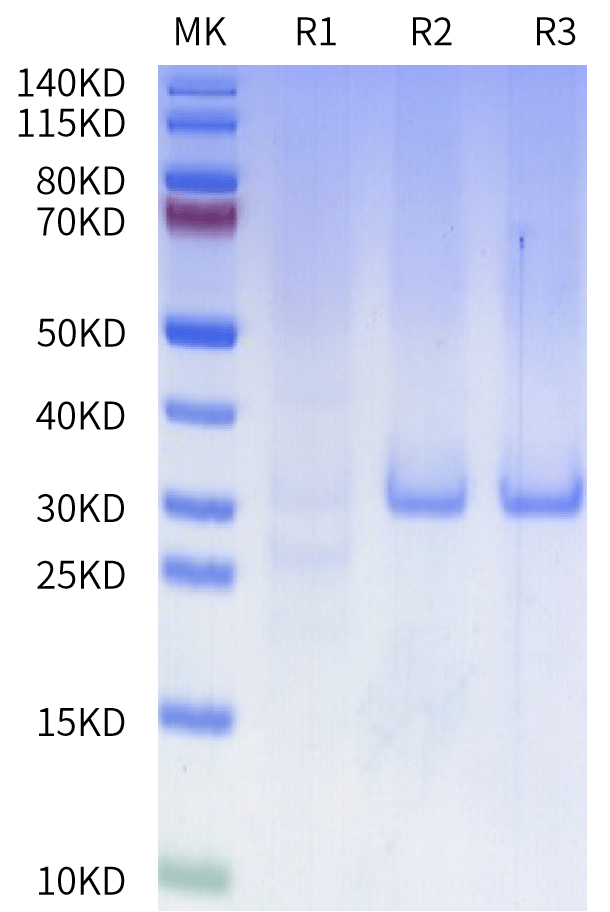| Weight | 1 lbs |
|---|---|
| Dimensions | 9 × 5 × 2 in |
| accession | Q92743 |
| express system | E.coli |
| product tag | C-His |
| purity | > 95% as determined by Tris-Bis PAGE |
| background | HtrA1 (High temperature requirement A1) family proteins include four members, widely conserved from prokaryotes to eukaryotes, named HtrA1, HtrA2, HtrA3 and HtrA4. HtrA1 is a serine protease involved in a variety of biological functions regulating many signaling pathways degrading specific components and playing key roles in many human diseases such as neurodegenerative disorders, pregnancy complications and cancer. |
| molecular weight | The protein has a predicted MW of 50.14 kDa. The protein migrates to 38-40 kDa based on Tris-Bis PAGE result. |
| available size | 100 µg, 500 µg |
| endotoxin | Less than 1EU per μg by the LAL method. |
Human HTRA1 Protein 2759
$300.00 – $1,000.00
Summary
- Expression: E.coli
- Active: Yes (catalytic)
- Amino Acid Range: Gln23-Pro480
Human HTRA1 Protein 2759
| protein |
|---|
| Size and concentration 100, 500µg and liquid |
| Form Liquid |
| Storage Instructions Valid for 12 months from date of receipt when stored at -80°C. Recommend to aliquot the protein into smaller quantities for optimal storage. Please minimize freeze-thaw cycles. |
| Storage buffer Shipped with dry ice. |
| Purity > 95% as determined by Tris-Bis PAGE |
| target relevance |
|---|
| HtrA1 (High temperature requirement A1) family proteins include four members, widely conserved from prokaryotes to eukaryotes, named HtrA1, HtrA2, HtrA3 and HtrA4. HtrA1 is a serine protease involved in a variety of biological functions regulating many signaling pathways degrading specific components and playing key roles in many human diseases such as neurodegenerative disorders, pregnancy complications and cancer. |
| Protein names Serine protease HTRA1 (EC 3.4.21.-) (High-temperature requirement A serine peptidase 1) (L56) (Serine protease 11) |
| Gene names HTRA1,HTRA1 HTRA PRSS11 |
| Protein family Peptidase S1C family |
| Mass 9606Da |
| Function Serine protease with a variety of targets, including extracellular matrix proteins such as fibronectin. HTRA1-generated fibronectin fragments further induce synovial cells to up-regulate MMP1 and MMP3 production. May also degrade proteoglycans, such as aggrecan, decorin and fibromodulin. Through cleavage of proteoglycans, may release soluble FGF-glycosaminoglycan complexes that promote the range and intensity of FGF signals in the extracellular space. Regulates the availability of insulin-like growth factors (IGFs) by cleaving IGF-binding proteins. Inhibits signaling mediated by TGF-beta family members. This activity requires the integrity of the catalytic site, although it is unclear whether TGF-beta proteins are themselves degraded. By acting on TGF-beta signaling, may regulate many physiological processes, including retinal angiogenesis and neuronal survival and maturation during development. Intracellularly, degrades TSC2, leading to the activation of TSC2 downstream targets. |
| Subellular location Cell membrane. Secreted. Cytoplasm, cytosol. Note=Predominantly secreted (PubMed:15208355). Also found associated with the plasma membrane (PubMed:21297635). |
| Tissues Widely expressed, with strongest expression in placenta (at protein level). Secreted by synovial fibroblasts. Up-regulated in osteoarthritis and rheumatoid arthritis synovial fluids and cartilage as compared with non-arthritic (at protein level). |
| Structure Forms homotrimers. In the presence of substrate, may form higher-order multimers in a PDZ-independent manner. Interacts with TGF-beta family members, including BMP4, TGFB1, TGFB2, activin A and GDF5 (By similarity). |
| Domain Th |
| Target Relevance information above includes information from UniProt accession: Q92743 |
| The UniProt Consortium |
Data
Publications
Publications
| pmid | title | authors | citation |
|---|---|---|---|
| We haven't added any publications to our database yet. | |||
Protocols
| relevant to this product |
|---|
Documents
| # | ||
|---|---|---|
| Please enter your product and batch number here to retrieve product datasheet, SDS, and QC information. | ||
















